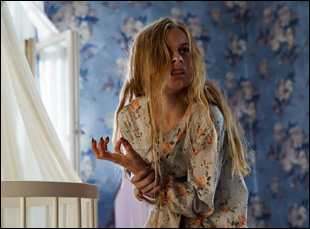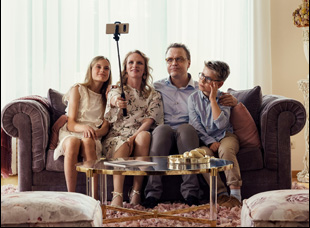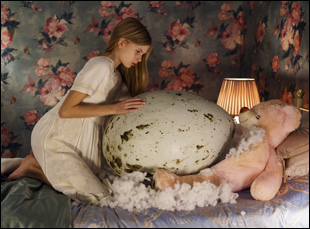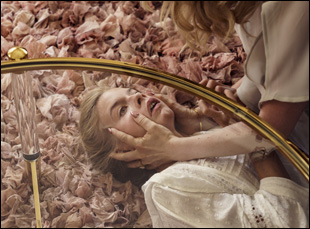When you enter the home of the family at the center of “Hatching,” it’s telling that the camera couldn’t possibly be guided solely by human hands, gliding effortlessly into the immaculate duplex of a social media influencer (Sophia Heikkilä) and her henpecked husband (Jani Volanen) with their two perfectly coiffed kids Tinja (Siri Solalinna) and Matias (Oiva Olllila) as they sit for a portrait. It’s quite literally all roses in the background with the mother’s choice of floral prints for every room in the house, but even before a black bird can come in to crash the proceedings in the engrossing narrative debut of Hanna Bergholm, something seems rotten as there’s clearly some ugly behavior involved behind the scenes of the “Lovely Everyday Life” videos that make their way online, a pursuit that the unnamed mom is more devoted to than her kids though she’d be the last to admit it.
What attention Tinja may not receive from her own mother as she enters puberty, she starts to lavish on the egg she comes across after the death of the bird, and as it grows bigger than any typical fowl ever could be, she ends up doing even more backflips attempting to keep it a secret than she does in her practice as an accomplished gymnast. Brilliantly, the egg begins to bulge to extremes as Tinja is asked to carry not just this secret but many others within the family in “Hatching,” which Bergholm developed from a single line pitch she heard from screenwriter Ilja Rautsi during a professional speed date set up in their native Finland into a debut truly monstrous debut, demonstrating outsized talent to go along with the creature that ends up hiding in Tinja’s closet, waiting to pounce.
After having previous experience directing children’s television, the director subverts her soft touch with young actors into guiding a chilling performance from Solalinna, but her sensitivity as well as that of Rautsi’s extend into tapping into truly unsettling notions of how fear can be passed along from one generation to the next and the pressure placed upon the young woman to start making adult decisions before her time. Following its Sundance premiere where it was a standout in the Midnight section, “Hatching” is arriving in theaters this week and Bergholm took the time to talk about cracking a few eggs herself to make such a delicious coming-of-age thriller, finding subconscious ways to unnerve throughout the film and working with physical effects to create such a memorable movie monster.

Yeah, it really was about a boy hatching a doppelgänger out of an egg and I thought that I have never seen a film like this before. I always like to tell stories in a way that its lead character experiences it and in this sentence, I felt I could really do that.
It starts with that brilliant opening shot that seems a bit otherworldly in how there’s unnatural glide to it, but of course it’s revealed to be a cellphone video from a savvy influencer who knows how to use a gimbal. How did that come into the mix?
Yeah, in the first draft of the script, we didn’t yet have this social media element in there. It was just a mother who tries to keep up the appearance of her happy family. But then I started to think what is today’s way of keeping up appearances? That is social media and then it really started to make sense to me. I wanted to design the whole world of this film to look like this mother’s perfect life in her vlog and I also wanted to have this opening shot of the camera gliding in like a bird would fly in and to present mother’s need in filming everything and portraying these happy moments of the family to the whole world.
And we shot all that in one day and we had a real bird flying there. I don’t know how many shots in one day, but when the bird flies inside and crashes everything, we didn’t have much time and we broke things – a chandelier and everything. [laughs] Everything was challenging [on this film], but also that’s what made it fun. We had a puppet, we had children, we had a baby, we had a real bird, a real dog. Everything you can name, we had there.

Yeah, that was very cool because it’s supposedly happening in Finland, but I wanted to create the world for Finnish audiences that looks like Finland, but a little bit weird and that anyone, anywhere in the world could be like, “Oh yeah, this could be my upper middle-class neighborhood, but not quite. There’s something wrong.” So we searched for a long time in Latvia, finding these locations and finally we found this suburb with these lovely white houses, but all the houses matched, so it was quite creepy.
What was it like picking out the wallpaper? It’s oppressively cheery.
That was a very long process because from very early on, I told our production designer Päivi Kettunen, I really want to have these pastel colors and this rose wallpaper. I had a very precise description of this girl’s room. I wanted it to have some green because it’s the color of the forest, but it has to have these roses and something very feminine like pink, but it’s not wallpaper that a preteen would pick herself, that it’s obviously the mother’s choice. Päivi searched and searched for a long, long time and we had multiple options of the wallpapers and finally she called me and said, “I found it! I found it!” And when we realized this wallpaper comes in different colors, we decided to have the same wallpaper in every room, so it’s just so many roses, it’s just…”Ahhh, just too much!” [laughs]
It feels like the extremes informed each other, like when you go in one direction stylistically, you could go just as far in another, particularly with how the film works with light and dark. Was that actually the case?
Yeah, I wanted this film overall to be [relatively] light because this is the mother’s world and she doesn’t allow any dark secrets in the family, so then there are no dark shadows. Everything’s lovely pastel colors or colors, but the dark scenes are where the creature lies and with the creature, the girl can place her own disabilities and sorrow and ugliness – all those emotions that she feels that are forbidden. Therefore I think even though the creature is scary, in this darkness and terror, there’s also an element of comfort in facing your fears and your own emotions.

Yeah, what was important was for them to get to know each other, especially Siiri because she had just turned 12, and [she was] playing this double role and she had never acted anywhere before, so it was very important that she felt safe. In rehearsals, it was also about getting the input of the actors and because Siri is so naturally talented at movement, I had this thought that we had a stunt coordinator who could teach her to move, but then I realized that her own inventing of ways to move was much more interesting, so I just said to the stunt coordinator, “Don’t teach her anything. Let her find ways to move” and that was very cool.
Because the animatronic creature becomes such a character to act against, is that something you can actually bring into rehearsals or can you only incorporate that once you get to set?
We had a short period of rehearsals with the actors and the animatronic puppet and before that, I visited the workshop of the puppeteers [when] it was just a skeleton of the puppet, trying different things with the puppeteers and finding out what the puppet could do well and I filmed all those rehearsals. Based on that, we drew storyboards so then we knew what the puppet can do and what looks good on screen and we [could draw] storyboards for each action. Then before the shootings, we had rehearsals with the actor and the puppet, but it was very technical because every little movement with the puppet needed a lot of takes to make it look real.
But we had five puppeteers who had been doing the “Star Wars” – we designed the look of the creature in Finland with two concept artists, so it was me explaining what I wanted the creature to look like and they made a 3D sculpture and I contacted Gustav Hoegen, our animatronic designer who has done “Star Wars” and “Jurassic World,” and he saw the concept images and got excited. Then their team did it and sent me pictures at each stage and asked my opinion at each stage of the puppet when it was getting ready, so when it was really done, I just really admired the craftsmanship of everyone involved. Everyone who painted the skin of the puppet, or painted the eyes, it’s such skilled work.

This is wonderful and it really feels like a great reward, getting such good feedback. What was wonderful in those early reviews we got, it seems like people understood the themes in this film and that so many reviews have praised all the elements of the film. That is so cool because it is a team’s work and I really love how everybody’s work has been noticed, so it feels wonderful and I would hope it gets people to see the film because that’s of course is what we want as filmmakers – to make something that people see and then they start to think about.
“Hatching” will open on April 29th in select theaters including the IFC Center in New York and the Alamo Drafthouse, the Laemmle Glendale and AMC Burbank 16 in Los Angeles. A full list of theatres is here.




